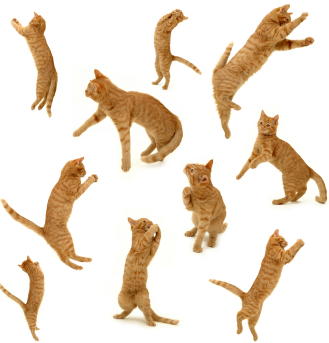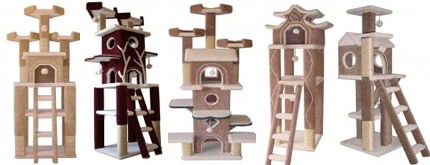Cat Exercise

Cat exercise is good for cats...both physically and mentally. It keeps their minds busy and they get a good old-fashioned cardiovascular workout. If your cat is an indoor cat, which the majority of cats are these days, it's especially important that you pay attention to the amount of activity she's getting every day. All living creatures benefit from moving around and cats are no exception.
For our feline friends, the concept of exercise is quite simple: rigorous playtime, something your cat probably already enjoys but doesn't do on a regular basis. Cats tend to mirror their American owners; they weigh too much, eat too much, and aren't active enough. According to The Cornell Book of Cats, approximately 25% of American cats are overweight.
Overweight felines are more susceptible to diseases and ailments such as diabetes mellitus and liver disease. In addition, they tend to have a shorter life span than their more active counterparts. If your cat is chubby, you may be saving her life by putting her on a fitness plan of cat exercise.
Get off on the right foot by taking your cat to the vet to be sure she won't be harmed by an increase in activity. Determine if she really is overweight (remember that even if she's slim and trim, she'll benefit from regular cat exercise).
Ask your vet for your cat's optimum body weight range, and check it at home every once in a while to make sure she gets and stays in the range. I've found the easiest way to weigh my cats is to get on the scale, holding the cat in my arms, and then subtracting my weight to get the cat's weight.
According to Cornell, between eight and 12 pounds is normal for most cats, and anything 15 to 20 percent higher than that is considered obese. Other indicators include your cat having problems breathing and if she has skin problems because she can't groom herself properly.
If your cat does have a weight problem, seeing the vet will help you determine the cause of it. Most likely, it's because she's eating a diet too high in fat and has a lifestyle too low in activity. But if it is due to some other hidden problem like a hormone imbalance, your vet may uncover it. Once you've got a clean bill of health from your vet, sit down and plan your cat exercise regimen.
To start, don't overwhelm your cat with too much cat exercise. Plan on 10 minutes of exercise twice a day and stop while the cat is still excited about it. After than you can plan to build up to 15 or 20 minutes a day, if your cat will tolerate it.
But again, don't push. Tailor the cat exercise program to your cat's temperament. Something else that will help excite your cat about playtime (exercise time) is keeping toys and playthings out of sight. find a drawer in the kitchen where you can stash everything.
Cats can become bored with toys that are left out all the time so buy a number of toys and rotate them on a regular basis. The key to making your cat exercise program a success is preventing boredom. In addition to starting slow and putting toys away, you can use the cat's naturally predatory tendencies.
One type of toy that's popular with the feline set is based on the concept of a fishing pole. Let the toy land, pull it along, and get the cat to chase it. Such games will bring out your cat's natural tendencies to chase a moving object. Make it look like prey...and your cat will be sure to like the game. You don't have to spend a fortune on toys to get your cat interested.
There are some interesting items around that house that will do. A crumpled up paper, walnuts in the shell, an old tennis ball...these all work at my house. But if you want to see what's available try Amazon's variety.....
If game playing gets difficult to keep their interest, try leash walking. Since most indoor cats are not used to the outside, it can be challenging. A method that works for some people is to buy the harnesses and leashes and leave them laying on the floor for a few weeks so they get accustomed to the feel and smell of them.
Warren and Fay Eckstein, the authors of How to get Your Cat to do What You Want, are strong believers in walking cats on a leash. They believe it saves them from boredom, gives them some supervised freedom, and, practically speaking, makes traveling with them much easier.
On a personal note, I tried leash walking Diablo (my late Himalayan cat), and although I tried for months, all he would do is flop down and I had to drag him around like I was mopping the driveway with him. I finally gave up. I did have success with his sister Bandita because she loved to go outside and it was the only way to achieve it. So, start slow. don't expect too much of an indoor cat right away and let your cat get used to it.
Patience, patience and more patience may win the battle. Also, experts say a harness is safer and kinder to a cat than a collar. Put the harness on the cat for short periods, and let her drag the leash around the house for a little while before you think about going outside.
After an indoor period of adjustment, allow your cat to take the lead in exploring the outdoors. Take her to the door and let her sniff around while you hold the leash, and allow her to lead the way. Use verbal encouragement, and again, lots of patience...and coax your cat outdoors.
Speak to your cat in a light, friendly upbeat voice, and try to send her the message that everything is okay. If she's not ready, don't push her or your walks will become a chore for both of you.
Try to create an environment where the cat won't be frightened on her first trip. Keep your excursions limited to the backyard for the first week or two and graduate to public sidewalks only when your cat seems ready. Your cat will give you the signal when she's ready to move on and explore more territory.
Click on the image below to view Custom Cat Furniture by CatsPlay.

Eventually, with a little time, and lots of patience, you and your cat will be enjoying regular forays around the neighborhood. Don't forget your common sense, watch for dogs and sharp objects, keep an eye on your cat at all times and be wary of fleas and ticks. And don't expect that you will be able to make the cat exercise time your exercise time. Cats move slowly, like to sniff and explore, and won't be pushed around.
Related Articles......
Return from Cat Exercise to Cat Health Homepage
Having trouble finding what you need? Cat Health Index & Site Map
OR
Do you have a question to ask?...Questions
OR
Do you have a cat story to share?...Simply click here to go to that page!
Copyright@2010-2020 All rights reserved.Cat-health-detective.com
This website is information only. Consult a veterinarian for medical assistance

"Like Us" on Facebook
or...
"Like Us" here




















